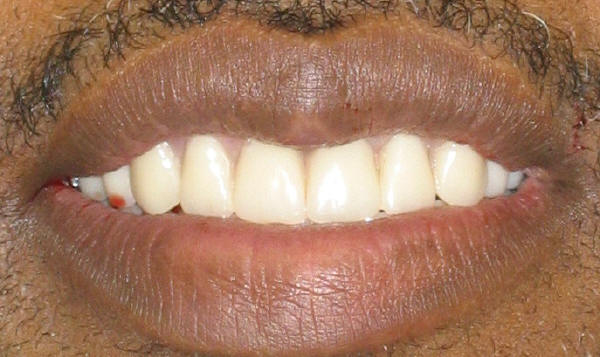 |
|
|
Fig.1 |
Fig.2 |
Dental Education Lecture: Immediate Denture
 |
|
|
Fig.1 |
Fig.2 |
To make complete denture, traditionally we first extract remaining non-salvageable teeth, let the wound heal in about two months, and take impression. It takes about another one month to make a good denture. In modern era, it is not practical. We cannot let patients walk around toothless for two to three months. Furthermore, it is difficult to re-establish bite long after extraction. Sometimes patients do not know how to bite correctly without teeth. Their lower jaw shifts.
Immediate denture provides a solution to problems associated with traditional denture fabrication. Before extraction, the doctor takes impression first, uses remaining teeth to determine the bite, and sends the case to a lab. When dentures return to office, the doctor extracts the teeth and inserts the dentures immediately. You look like Fig.1 when you arrive at the dental office. When you leave the office, you look like Fig.2. Last, maybe not the least, advantage of immediate dentures is that they act as a bandage to stop bleeding after extraction. You get used to immediate dentures quicker than traditional dentures.
We use immediate dentures as a temporary measure. In a month or two, the immediate dentures start getting loose because of post-extraction gum and bone changes (shrinking). There is a special method to make a new set of definitive denture, called Celara, invented by late Dr. Graham Philp. A dentist uses immediate dentures to take impression, pour models (duplicate immediate dentures with better lining and adaptation), and send the case to a lab again. You wear the immediate dentures, while the new set of definitive dentures are being made in the lab. The new dentures fit much better and will be stable for a long time. We can reline the immediate dentures as backup dentures, in the same fashion as we have extra pair of glasses just in case.
When we lose teeth, we also lose bone which supports the teeth. The process of losing our bone is continuous and non-stopping, although at a slow rate. In time we have to make a new denture. Finally our jaw bone becomes so small that even a new denture does not help much. We will discuss how to handle loose denture next.
Xin Wei, DDS, PhD, MS 1st edition 02/16/2009, last revision 09/28/2012